XC90 Hauls Volvo to Elite SUV Status
By John Gilbert
The Volvo XC90 is an automotive rarity. While it is entirely new for 2016, it combines every contemporary and futuristic new element together in perfect harmony to make a whole that is far greater than just the sum of its parts.
The new XC90 is the largest Volvo, and as large SUVs go, it might be my favorite. Understand that I really like small, compact crossover SUVs, and with the herd of new ones hitting the market this year, I am a long way from determining a favorite among the smaller “CUV” group. With larger SUVs, I have less hesitation: The 2016 XC90 is so loaded with technical, aesthetic, performance, comfort, and safety features that anybody looking for a luxury SUV should be urged to consider it.
My impression from the first photos I saw was, “So this is what would happen if Volvo tried to build a Tahoe?” Thus, I was pleased to be invited for the introduction of the new XC90 in Santa Monica, Calif., because the vehicle is vastly more impressive in real-life than in those first photos. Yes, it is bigger and a bit more squarish than the more curvaceous original XC90. But in person, it looks classy, not boxy; stylish, not stodgy.
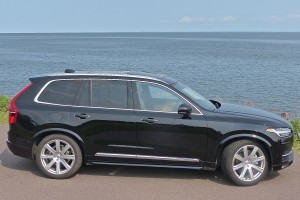
The 2016 XC90 uses its squarish exterior to house a full array of comfort, performance and luxury features.
At 194.8 inches in length, the XC90 is 10 inches shorter than a Tahoe, and 30 inches shorter than a Suburban, but it makes excellent use of its interior space and can tow up to 5,000 pounds with engine choices that include 400 horsepower and 372 foot-pounds of torque.
As unique as the exterior looks, that might be the least impressive of the new XC90’s assets. It comes in three designations — the Momentum, the Inscription, and the R-Design. Each can be had with the choice of engines: the T6, which is a new and sophisticated 2.0-liter 4-cylinder with both supercharging for low-end thrust and turbocharging for high-end power, or the T8 “twin engine” alternative, which has the same T6 engine linked to a C-ISG battery pack/electric motor unit to generate electricity for the latest in hybrid technology.
The T6 produces 316 horsepower and 295 foot-pounds of torque and will zip from 0-60 in about 6 seconds with an EPA fuel economy estimate of 22 miles per gallon. The T8 produces 400 horsepower and 472 foot-pounds, improving acceleration time to 5.6 seconds and attaining a lofty 59 mpg high. With both engines available in all three models, all can be obtained in basic form or with popular options grouped in Vision, Convenience, or Climate packages, and a full slate of specific options also are available.
Prices for well-equipped standard vehicles range from $48,900 for the Momentum T6 or $68,100 with the T8; the high-performance R-Design ranges from a $52,900 base T6 to $70,000 for the T8; and the Inscription opens at $54,500 as a T6 or $71,600 for the T8.
Shortly after the introductory drive, during which we sampled both engines and spent a lot of time enjoying the T8’s full-power hybrid, I got a chance to test a T6 Inscription for a week’s follow-up. Scaling the steep hills of Duluth, taking the freeway to Minneapolis, or negotiating the rocky North Shore of Lake Superior, those numerous features, and the enormous, full-length skylight/sunroof that is enlarged 50 percent, made it a dream vehicle for summertime cruising or Highway 61 Revisiting.
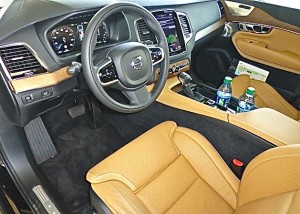
Rich Nappa leather on seats and dashboard, and real walnut wood and aluminum trim encase occupants in opulence.
Volvo has had the best seats in the industry for decades, and in the new vehicle, they’ve been redone, with the same familiar Swedish orthopedic stability and comfort, but with slimmer backrests redesigned to create more rear knee-room. The second-row seats slide an inch and a half fore and aft and recline, and one-hand access to the third row is handy, whether the seats are in place for 7-passenger use, or folded down to offer 85 cubic feet of storage.
The first XC90 in 2005 was an extremely adventurous attempt by Volvo to enter the realm of Sport-Utility Vehicles. Of course, Volvo did it in its own inimitable fashion, going for sport and utility, but only after living up to its commitment without compromise on vehicle safety. I witnessed one flung through the air in a rollover test at the Gothenberg, Sweden, safety center. After coming down on its roof and rolling over four and a half times, the crash-test dummies were healthy enough to get ready for more rides.
It was an impressive vehicle, with a high-performing Yamaha-designed V8 engine inside a shell that was like a taller, stronger, bulgy version of Volvo’s legendary V70 and XC70 station wagons, making it well suited to take Volvo into an expanding SUV world.
For the 2016 restyling, nearly everything has changed in Volvo’s world. First, Volvo officials can hardly remember the days when the Swedish company was owned — and some say held back — by Ford Motor Company. It was threatening solvency as an independent at a time when a Chinese holding company that also owns the Geely car company took over ownership.
China was zooming upward to become, primitive or not, the largest car-market in the world. So it was a perfect match. Volvo needed only an infusion of money to keep building safe and now-stylish cars, and China beckoned with enormous potential. To sell cars in China, a company must partner with a Chinese car brand, and with Volvo now a sibling of Geely, that is no problem. There are a lot of Volvos being sold in China, where a new construction facility is in the works, meaning there will be a lot more to come.
Meanwhile, back in Sweden, Volvo has streamlined its engine line, hiring Lutz Stiegler to be director of powertrains, German accent and all. Experienced and impressed with the BMW, Audi, Mercedes and Volkswagen powertrains of his German homeland, Stiegler has the background and the discipline to oversee one of the biggest new engine plans in the industry.
Volvo no longer will be producing vehicles with V8s, or the in-line 6, or 5-cylinder engines. Every Volvo vehicle including S60 sedans, V70 wagons, and, yes, XC90 SUVs, will now be powered by the new 2.0-liter, in-line 4-cylinder, making up for any power shortages with supercharging, turbocharging, and electric motor bolstering. The sophisticated 4-cylinder represents completely new architecture, Stiegler explained, and can be used in both gasoline and diesel applications.
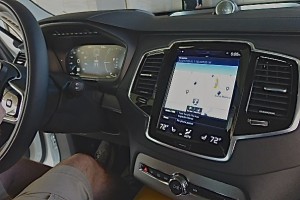
The large nav screen can be changed with a swipe of the hand over the surface, even replicating control knobs.
In the XC90, we’re dealing with the gasoline version, which requires additional power over and above a typical 2.0. An advance combustion system, with high compression and variable valve operation, and advance boosting from the Eaton supercharger for low-end power, and the Borg-Warner turbocharger for the high end, that transverse-mounted 2.0’s 316 horsepower peaks at 5,700 RPMs, and the 295 foot-pounds of torque peaks at 2,200 RPMs and holds it up to 4,500 RPMs.
If the way you’re driving convinces the computer that you don’t need the hard-accelerating low-end boost from the supercharger, it is decoupled so as not to use any of the belt-driven power taken to run it. In that form, it is designated as T6, and it easily propels the 4,627-pound XC90 around curvy highways or through the mountains. Premium fuel is suggested, but not demanded.
The new SPA platform, flexible enough to also underpin all future large Volvo sedans, has a newly designed suspension, including a rear unit that features transverse springs to keep it low, and air suspension all around to make ride-height adjustable. It handles as though it thinks it’s a sports sedan, more than an SUV, and it feels low and stable, clinging to the prescribed arc you’ve established with the steering wheel. The all-wheel drive models feel even more stable than the front-drive models, although the lighter front-wheel drive feels more agile and more tossable, if you’re into that type of excitement.
For the ultimate XC90, the potent little T6 engine can be upgraded to the T8 version, as a hybrid model. The 316 horsepower jumps to 400 with the addition of 87 horses from the LG battery pack, which has its vertically aligned 96 Lithium-Ion cells mounted mid-chassis, and add the kick of an extra 87 horsepower and 177 foot-pounds of torque. When all the equations are compared, the XC90 grows from 316 horses and 295 foot-pounds of torque to 400 horsepower and 475 foot-pounds of torque, once coupled to the hybrid system.
The added power improves 0-60 times from 6.1 with the non-hybrid to 5.7 with the added electrical charge. A larger difference is growing from 25 miles per gallon to an estimated 59 mpg with the hybrid.
“We developed electrification with the platform, so we built the starter-generator integrated with the crankshaft, and the Lithium-Ion battery pack’s six modules fit longitudinally down the middle of the car,” Stiegler said. “Power from the engine goes to the front wheels, while the battery powers the rear wheels, augmented by the gas engine.
“The combustion engine and electrical system go very good together. Electrical power is most efficient at low speed, and combustion engines are more effective at higher speed. So we take most of the low-end away from the combustion engine and make it electrical, then at higher speed we go to the combustion power. And we combine the two for hardest acceleration.”
The hybrid can operate for 16-17 miles on strictly electric power, and once depleted, the electrical power can be rejuvenated by the engine and the brake energy recuperated from the rear axle, or by plugging in the vehicle. A full charge can be gained in 6-7 hours on a household 110 plug in, or in 3-3.5 hours at 220. The T8 has a unique feature that allows the driver to switch to a manual charging system to bolster the system to allow 7-8 miles of pure electric operation, an impressive device for some international cities that have zero-emission restrictions for vehicle operation.
Stiegler pointed out that Volvo will continue to pursue advances in electrification, and while he said he is impressed with the performance of the all-electric Tesla. “But if everyone drove Teslas,” he said, “it’s completely unrealistic to expect there to be enough charging stations.”
“Our T8 is ideal, because it makes sense to use the plug-in electrical power in town, and after driving it as a pure electric around town, you then can use it as a normal hybrid, with the combustion engine providing most of the power while recharging the battery pack.”
If the sticker prices seem steep, consider the amount of high-tech equipment that comes standard, such as the 8-speed Geartronic transmission with start-stop shutoff at stoplights, instant traction and stability on the all-wheel-drive system, double-wishbone front and rear integral suspension, adjustable drive modes, and a seemingly endless array of safety features.
Every XC90 also includes collision avoidance for vehicles, pedestrians and cyclists, lane-departure warning and roll stability control, with all manner of airbag and Volvo’s typical insistence on the high-strength steel unibody safety cage. While aluminum is gaining popularity for its strength combines with lighter weight, steel construction can consist of five levels: mild, high-strength, very high-strength, extra high-strength, and ultra high-strength.
Jan Ivarsson, senior technical advisor of safety for Volvo, explained that the XC90 has, “a passenger compartment completely encircled with ultra high-strength steel,” and also adds a technique for off-road crashworthiness.
A vision package includes blind-spot detection in full-surround style; convenience package offers adaptive cruise control and parking assist; and the climate package offers front and rear heated seats. A Bowers & Wilkins audio upgrade adds 1,400 watts and 19 speakers, 4-corner air suspension, heads-up display, wheels measuring 20, 21 and 22 inches, a wood steering wheel, and integrated child booster cushions.
Volvo stresses that they don’t want cars that drive themselves, and prefer to offer an amazing array of cameras and radar devices to detect warn of lane variations, obstacles front and rear, with the ability to tighten harnesses, and load up brakes in an attempt to assure that drivers are conscious and aware of how to make themselves and their occupants as safe as possible. The car can detect a loss of attention and gently alert the driver that it might be time for a break.


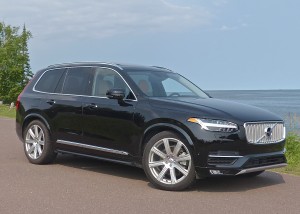
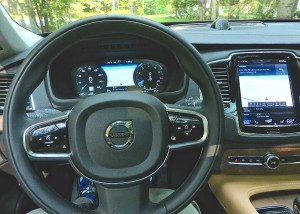

 John Gilbert is a lifetime Minnesotan and career journalist, specializing in cars and sports during and since spending 30 years at the Minneapolis Tribune, now the Star Tribune. More recently, he has continued translating the high-tech world of autos and sharing his passionate insights as a freelance writer/photographer/broadcaster. A member of the prestigious North American Car and Truck of the Year jury since 1993. John can be heard Monday-Friday from 9-11am on 610 KDAL(www.kdal610.com) on the "John Gilbert Show," and writes a column in the Duluth Reader.
John Gilbert is a lifetime Minnesotan and career journalist, specializing in cars and sports during and since spending 30 years at the Minneapolis Tribune, now the Star Tribune. More recently, he has continued translating the high-tech world of autos and sharing his passionate insights as a freelance writer/photographer/broadcaster. A member of the prestigious North American Car and Truck of the Year jury since 1993. John can be heard Monday-Friday from 9-11am on 610 KDAL(www.kdal610.com) on the "John Gilbert Show," and writes a column in the Duluth Reader.